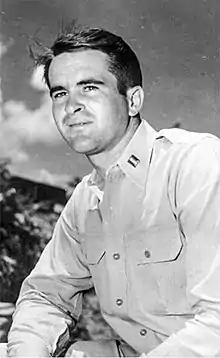Eugene A. Valencia Jr.
Eugene Anthony Valencia Jr. (13 April 1921 – 15 September 1972) was a 3rd highest scoring United States Navy fighter ace in World War II with 23 claims.[1][2]
Eugene A. Valencia Jr. | |
|---|---|
 Eugene Valencia | |
| Born | 13 April 1921 San Francisco, California |
| Died | 15 September 1972 (aged 51) San Antonio, Texas |
| Allegiance | United States |
| Service/ | United States Navy |
| Years of service | 1941–1962 |
| Rank | Commander |
| Unit | USS Essex VF-9 |
| Battles/wars | World War II |
| Awards | Navy Cross Distinguished Flying Cross (6) Air Medal (6) |
Early life
A native of San Francisco, Valencia was born on 13 April 1921 and attended junior college before enlisting in the United States Navy for flight training in 1941.[2]
Naval career
Valencia received his wings in February 1942 and joined Fighting Squadron 9 a year later. During his first combat deployment to the Pacific, he flew Grumman F6F Hellcats from USS Essex in 1943–44. At the end of the first cruise in February 1944, Lieutenant (JG) Valencia was an ace with seven victories, including three in the large dogfight over Truk Atoll on 17 February.
Promoted to full lieutenant, Valencia prepared for VF-9's next deployment. He trained three other pilots in his "mowing machine" tactics, which became perhaps the deadliest naval fighter division (four planes) of the war. "Fighting 9" flew from USS Lexington and USS Yorktown during 1945, and Valencia's division accounted for 43 of the squadron's 130 victories. Valencia himself joined the ranks of the "aces in a day" with six kills over Japan on 17 April,[3] and at war's end all his division's pilots were aces. James B. French had 11 victories, Harris Mitchell 10, and Clinton L. Smith 6.[4] With 23 victories, Valencia remains the United States Navy's third-ranking ace of all time.
Valencia remained in the navy after World War II ended, and served in a variety of roles including ordnance test, transports, and antisubmarine warfare. As a full commander, he was executive officer of VFAW-3, an air defense squadron, from 1958–1960.
Valencia's decorations include the Navy Cross, six Distinguished Flying Crosses, and six Air Medals.[2]
Later life
Valencia retired from the navy in 1962 and entered business in Southern California. He died at an aces reunion in San Antonio in 1972, aged 51.
References
- "Eugene A. Valencia, Navy Ace in Pacific". New York Times. 1972-09-18.
- "Eugene Anthony Valencia 13 April 1921 - 1972". Naval History and Heritage Command. Retrieved 2018-06-24.
- Valencia's memorable actions on 17 April 1945 are documented in Edward H. Sims' book Greatest Fighter Missions, as the final chapter of that compilation.
- Tillman 1996, p. 68
Bibliography
- Olynyk, Frank. Stars & Bars: A Tribute to the American Fighter Ace 1920–1972. London: Grub Street, 1993
- Tillman, Barrett. Hellcat Aces of World War 2. London: Osprey Publishing, 1996. ISBN 1-85532-596-9
- Guy Charles Throner Jr. (21 March 2014). THE LIFE AND EXCITING TIMES OF GUY CHARLES THRONER JR. Xlibris Corporation. pp. 103–. ISBN 978-1-4931-2880-8.
- Barrett Tillman (11 October 2012). Hellcat: The F6F in World War II. Naval Institute Press. pp. 58–. ISBN 978-1-61251-189-4.
- Thomas McKelvey Cleaver (31 May 2018). Tidal Wave: From Leyte Gulf to Tokyo Bay. Bloomsbury Publishing. pp. 136–. ISBN 978-1-4728-2546-9.